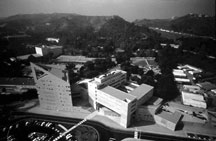|


Nelson Fine Arts Center, Arizona
State University, Tempe, 1989 and Classroom, Laboratory, Administration
Building, California State Polytechnic University, Pomona, 1992.
|
|
This
interview was begun in 1993 and was taken up four years later.
Geoffrey Baker: I can recall a meeting we had in 1985,
following a lecture you gave. I remember it vividly because it featured
several of your houses in the desert and works here in Albuquerque. Since
then you have won four important competitions: the Nelson Fine Arts Center
at the Arizona State University, Tempe; the Las Vegas Central Library
and Children's Museum; the American Heritage Center and Art Museum at
the University of Wyoming, Laramie; and the Classroom, Laboratory, Administration
Building at the California State Polytechnic University, Pomona. These
are all now built and have had extensive coverage and favourable reviews
in the architectural media. You have nine important projects that will
be completed within a couple of years. You have been featured in Time
magazine and are now well established as an architect with a growing international
reputation. I would like to begin by asking you how your education affected
your attitude to architecture? Where were you educated and were there
any special teachers, movements or attitudes that left a deep impression?
Antoine Predock: My education has been New Mexican in
an all-pervasive sense. Academically, the first two years I studied engineering.
I took a technical drawing course with Don Schlegel, a professor of architecture
who, in retrospect, had a profound influence on me. He was teaching engineering
part-time at the University of New Mexico as the School of Architecture
was coming into being.
GHB: Are you from Albuquerque?
AP: No, I was born in Missouri, but I decided to come
west. Through Schlegel's engineering drawing course, maybe almost subliminally,
he communicated to me the feeling that as an architect he was living his
work and it wasn't a job, it was nothing to do with the perfunctory eight
to five job that 'work' is often associated with. Schlegel had the kind
of integrity for his subject that was communicated without him having
to say it overtly. He was light-hearted, not a guru, but his life was
passionately engaged with architecture. What he was doing was teaching
mechanical drawing for engineers, but he somehow communicated that architecture
was something else, of a different order. So I then studied engineering
for a couple of years, found it rather unsatisfying, then, almost as a
whim, I decided to enrol in architecture, in my third year as a student.
|
Looking back, it was clearly the beginning of an inner quest that then,
as now, was unfashionable to talk about. My first studio course was with
Don Schlegel! By this time the School of Architecture was on its own feet
and rolling along - it had a regular degree sequence, and was overwhelmingly
right for me. It was kind of by accident, although how do you differentiate
destiny from accident? They can be one and the same. So it felt immediately
right. I almost finished my studies at the University of New Mexico, when,
near the very end of my tenure as an undergrad, I was restless. Don Schlegel
felt that I should leave. He characterised the situation as one in which
they had taught me all they could teach me, and I really should move on.
I was accepted at Columbia University, which was a graduate school, and
I finished there. I then had a traveling fellowship to go to Spain before
I came back to New Mexico in 1963. During that time, the mentor figure
I would mention is Schlegel himself, I think just because of a generally
inspiring aura about him as a teacher.
Regarding the great modern architects, I was really involved with Frank
Lloyd Wright. During my schooling I apprenticed one summer with a Wright
associate in Texas, Charles Adams. Charles's attention to detail, that
fanatical Wrightian pursuit of detail that grows organically from a larger
idea, really impressed me, and I almost left the University of New Mexico
to go to Taliesin to study. I was enamoured for about a year. In the background,
of course, were the great modern masters, Mies van der Rohe and Le Corbusier.
There was not enough emphasis on Alvar Aalto. I knew a little about Aalto.
I wish he has been emphasised more. Then in the early sixties, when the
word was getting around the country about Louis I Kahn's work, the Richards'
laboratories and his early master works, I really became interested in
Kahn, but I never met him until later. I heard him talk, but never studied
with him. So I would say that though Kahn and Frank Lloyd Wright were
the two masters that I would single out, it was Schlegel who was the lighting
flame.
|